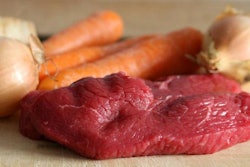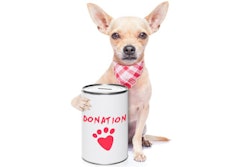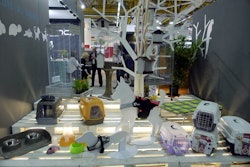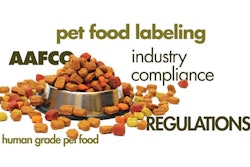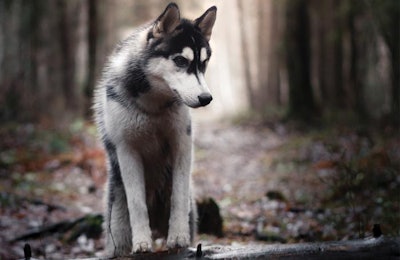
Since the crash of socialism and the opening of borders for free trade the Russian pet food market has been strongly dominated by international companies. According to data from Russia’s Association of Pet Food Producers, international pet food companies own an 80–85 percent share in total pet food sales. However, the situation may change in the coming years under the influence of a changing market.
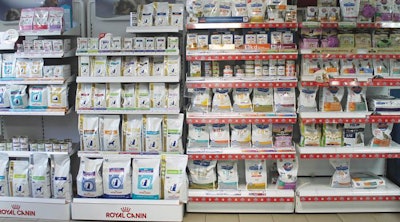
Russian pet food grocery shelves are dominated by foreign brands. | Vladislav Vorotnikov
Domestic pet food opportunities in a growing market
Domestic pet food companies in Russia can now successfully compete with foreign producers in terms of product composition, according to Dmitry Trukhanov, brand manager of R-Trade, a Moscow-based manufacturer of pet food. In the last couple of decades, he said, Russian companies have obtained market experience and have good formulas, even operating in the budget market segment. R-Trade currently produces 500–600 metric tons of pet food per month, a lower figure when compared to 2014 or 2015 primarily because company had to raise sales prices, said Trukhanov. He said that some raw materials are imported, so the devaluation of the Russian ruble increased the financial burden on domestic pet food manufacturers. At the same time, international companies, with the use of some internal resources, managed to keep the rise of prices rather moderate.
Russian pet food manufacturer KlinVet has been following a strategy of modernization to succeed in the domestic market. According to Maxim Malagin, director of KlinVet, beginning in 1998 (the founding of the company) KlinVet used pet food formulas developed by the Soviet Union’s Ministry of Defense for tracker dogs. After those initial years, however, the formulas were modernized, with the assistance of specialists from Denmark and England, in order to meet European standards of quality. KlinVet does not disclose production numbers, but estimates from Russian consulting agencies suggest it was close to 20,000 metric tons per year prior to the current challenges.
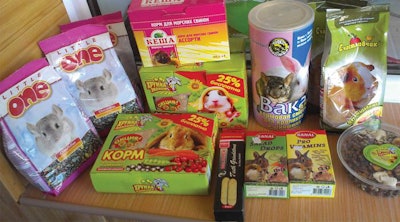
The majority of domestically produced Russian pet foods are sold in the budget segment of the market. | Vladislav Vorotnikov
Media presence and marketing
According to manufacturers in Russia’s domestic pet food market, in terms of quality their production could successfully compete with foreign brands, but international companies have a stronger presence primarily due to the large amount of money they spend on having a solid media presence. According to Trukhanov, Russian manufacturers are short of money to describe the merits of products as quickly and clearly as international companies do, using the most massive channel of communication — television. Russian producers, he said, are going a different way, communicating through exhibitions, printed materials and specialized media, but this way takes far more time to succeed.

In an attempt to strengthen their presence in the market, formulations and packaging of domestically produced pet food have improved. | Vladislav Vorotnikov
According to JSC Russian Pet Food Company’s press service, lack of funds spent on having a media presence can be considered a competitive advantage for the company, since it allows manufacturers to offer products at the best (lower) price. The Tambov-based producer operates locally and holds a share of about 15 percent in its own and a number of neighboring regions, producing 7,000–8,000 metric tons of pet food, according to various agency estimates.
Homeland Food positions itself as the only 100 percent Russian manufacturer of pet food. According to the company’s press service, independent domestic pet food manufacturers in the country are imitating foreign market players and using a cultural code which is not relevant to Russian cultural values. As a result, said the company, grocery shelves in the country have a strong dominance of trademarks with English names, even if the actual product is produced in Russia. In general, Homeland Food is part of growing trend in the Russian food industry where some manufacturers are trying to use consumer patriotism to boost sales volume, offering fully homemade products as a way to keep customer money in Russia.
In terms of marketing, Russian manufacturers said that international players are conducting aggressive policies in terms of cooperating with retail chains, demanding that their products be put in optimal shelf spots while products of Russian companies sit on lower shelves. According to Malagin, this was one of the main reasons KlinVet’s sales growth at one time reduced from 15 percent to a lower figure, due to the collapse of sales in retail chains.
The future of competition in Russia’s pet food market
Overall, Russia’s domestic pet food players are relying on a mix of modernization of their formulas, expansion of their brands and a play on the patriotism of the country’s citizens to compete in the internationally dominated current market. For those who are successful, opportunities remain as the market continues to grow.
Miratorg: a new domestic player in Russia’s pet food market
In general, it is thought that international pet food companies don’t care too much about domestic Russian producers, under the assumption that they don’t have the funds or technologies to become serious competitors. However, agricultural giant Miratorg, which recently disclosed plans to expand its business into the production of pet food, could be completely different story.
Miratorg is the second-largest producer of meat in Russia and the largest producer of compound feed. It processes nearly 1.4 million metric tons of feed ingredients annually, and will be able to produce large quantities of pet food at nearly zero cost from materials currently being considered waste.
Miratorg owners are also close to the country’s authorities, and as a result the company has state support, including tax breaks, in its projects. These factors have led Russia’s experts to predict that Miratorg entering the pet food market, which the company expects to do in the next couple of years, might significantly change the balance of power.


